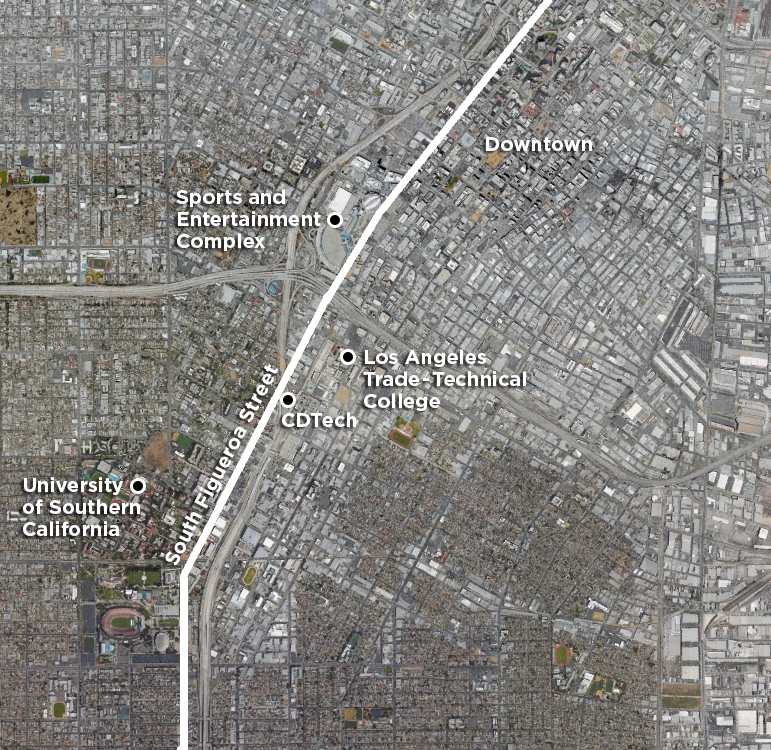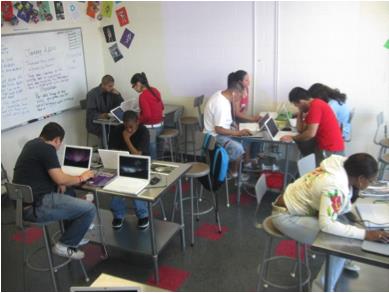IN THIS ISSUE:
Grantee Spotlight: Sustainable Design: At the Intersection of Research and Practice in Tucson
Empowerment and Inclusive Economic Development in South Los Angeles
Facilitating Community Change: Auburn University in Uniontown
Empowerment and Inclusive Economic Development in South Los Angeles
Substantial changes are taking place in the South Los Angeles neighborhoods that surround Los Angeles Trade-Technical College (LATTC). Historically home to working-class African-American and Latino families, the area has recently become a magnet of economic development. Particularly in the South Figueroa Street corridor connecting downtown Los Angeles in the north to the University of Southern California’s campus in the south and beyond, economic growth is creating opportunities for residents.

A series of grants from HUD’s Office of University Partnerships has helped connect residents of South Los Angeles with economic development opportunities along the South Figueroa Street Corridor. Credit: Google Earth
Situated just east of the corridor, LATTC has been working for nearly 20 years to ensure that development opportunities reach the longterm residents of South Los Angeles. The school is one of the few community colleges in the country with a community planning program. Students in the program learn through both traditional coursework and hands-on experience in the neighborhoods surrounding LATTC’s campus, where many of the students grew up. Complementing the community development program at LATTC is a nonprofit organization known as Community Development Technologies (CDTech), which focuses on community organizing and empowerment to give low- and moderate-income residents a voice in the decisions that are reshaping South Los Angeles.
This capacity building has been crucial, explains Benjamin Torres, executive director of CDTech, as expansion of the University of Southern California and the downtown area has exerted significant development pressure on South Los Angeles neighborhoods. The demand for student housing has already displaced neighborhood residents and has shaped economic and community development policies in the Figueroa corridor. For many years, community development that benefits both the university and longtime South Los Angeles residents has been supported by HUD’s Office of University Partnerships. The Office’s Community Outreach Partnership Centers (COPC) and Hispanic-Serving Institutions Assisting Communities (HSIAC) grant programs have supported resident empowerment through community organizing, implementing workforce development programs, and improving primary, secondary, and post-secondary education in the neighborhood.
Figueroa Corridor Partnership
LATTC used a 2004 COPC New Directions grant to collaborate with organizations that were addressing the employment needs of low-income residents in the neighborhoods along the corridor. According to Torres, the grant also allowed LATTC to refine its community planning courses and provided the community planning program with much-needed capacity building and stability in its early years. The grant was also used to better connect neighborhood residents with LATTC’s diverse educational opportunities and to train them for jobs created by the economic growth in their neighborhoods. In particular, the partnership has focused on the construction and tourism-related jobs that have been engendered by development of commercial, entertainment, sports, and convention facilities along South Figueroa Street that have contributed to the region’s economic growth.
Youth-Centered Community Stabilization

CDTech programs have helped bridge the technology divide facing many students in South Los Angeles. Credit: CDTech
In 2007, LATTC and CDTech received a $600,000 grant from the HSIAC program’s Community Building/Stabilization Initiative. The HSIAC funding was critical for developing initiatives to strengthen primary and secondary education in the Vernon-Central neighborhood adjacent to the LATTC campus. This funding leveraged an additional $4.4 million in program-related investments, including $1.2 million from the James Irvine Foundation to develop a program wherein students can earn a high school diploma, community college credits, and skill certificates in public service and hospital- and tourism-related fields. Other educational improvements included a computer curriculum and laboratory in a Vernon-Central middle school to bridge the technology divide in the neighborhood. As part of these efforts, the HSIAC grant helped create institutional relationships between the neighborhood schools and LATTC/CDTech while also leveraging additional grant funding.
Leadership development among youth was another program supported by the grant. Reaching more than 1,200 otherwise disempowered students over the grant’s duration, the program increased student involvement in public safety, workforce development, and other urgent issues for the community.
Along with these educational and leadership development efforts, LATTC offered courses to financially empower neighborhood residents. Nearly 800 residents participated in financial literacy workshops as part of the HSIAC grant. These workshops were supplemented with individual financial counseling sessions aimed at restoring credit and gaining access to mainstream financial services.
Community Empowerment Model
As development pressures in South Los Angeles intensify, LATTC is empowering residents so that they may benefit from the area’s economic growth. In 2011, the development of a mixed-use apartment and retail complex near the University of Southern California campus included local hiring for construction jobs and a medical clinic available to neighborhood residents. Torres notes that community engagement and advocacy during the development’s design and permitting helped ensure that a cross-section of residents benefited from the new project. This community engagement has been fostered through the years by Office of University Partnerships grants.
Source:
Dan Loeterman. 2008. “Long-term community residents oppose USC Master Plan details,” Strategic Actions for a Just Economy, 3 April. Accessed 25 November 2014; Interview with Benjamin Torres, executive director, Community Development Technologies, 25 November 2014.
×Source:
Documents provided by Kristine Williams, vice president of strategic initiatives, Community Development Technologies; Los Angeles Trade-Technical College. 2014. “Community Planning and Economic Development.” Accessed 25 November 2014.
×Source:
Interview with Benjamin Torres, 25 November 2014; Paulina Gonzalez. 2012. “South ‘Central’ Los Angeles: Residents Fight to Save Their Beloved Community in the Face of Expansion Plans,” Progressive Planning 192, 14–7. Accessed 25 November 2014; Documents provided by Kristine Williams, vice president of strategic initiatives, Community Development Technologies.
×Source:
U.S. Department of Housing and Urban Development, Office of University Partnerships. n.d. “Grantee Database.” Accessed 25 November 2014; Interview with Benjamin Torres, 25 November 2014; Strategic Actions for a Just Economy. n.d. “Figueroa Corridor Community Jobs Program.” Accessed 25 November 2014.
×Source:
Documents provided by Kristine Williams, vice president of strategic initiatives, Community Development Technologies.
×Source:
Alejandro E. Camcho. 2013. “Community Benefits Agreements: A Symptom, not the Antidote, of Bilateral Land Use Regulation,” Brooklyn Law Review 78:2, 355–6. Accessed 25 November 2014; Interview with Benjamin Torres, 25 November 2014.
×

